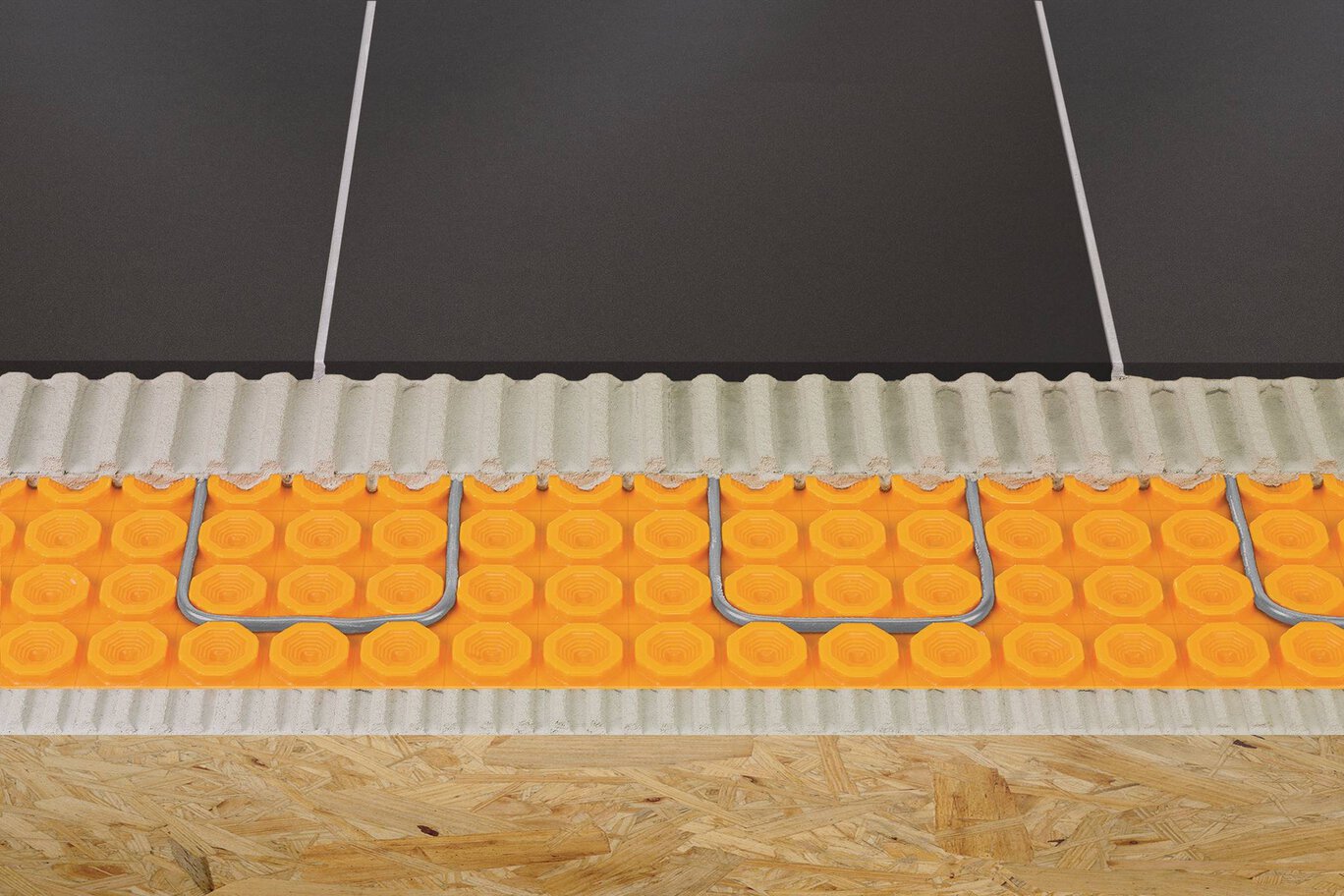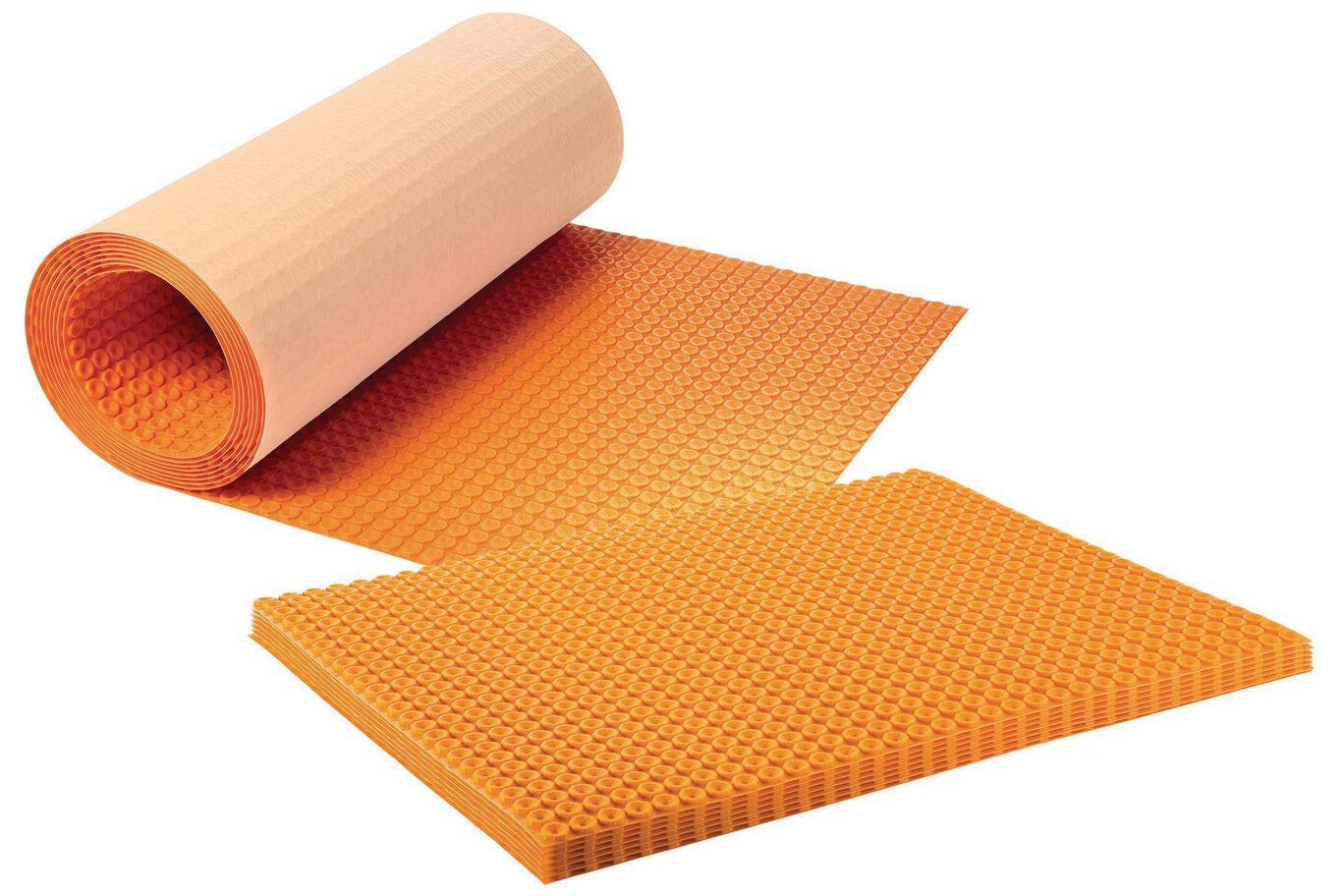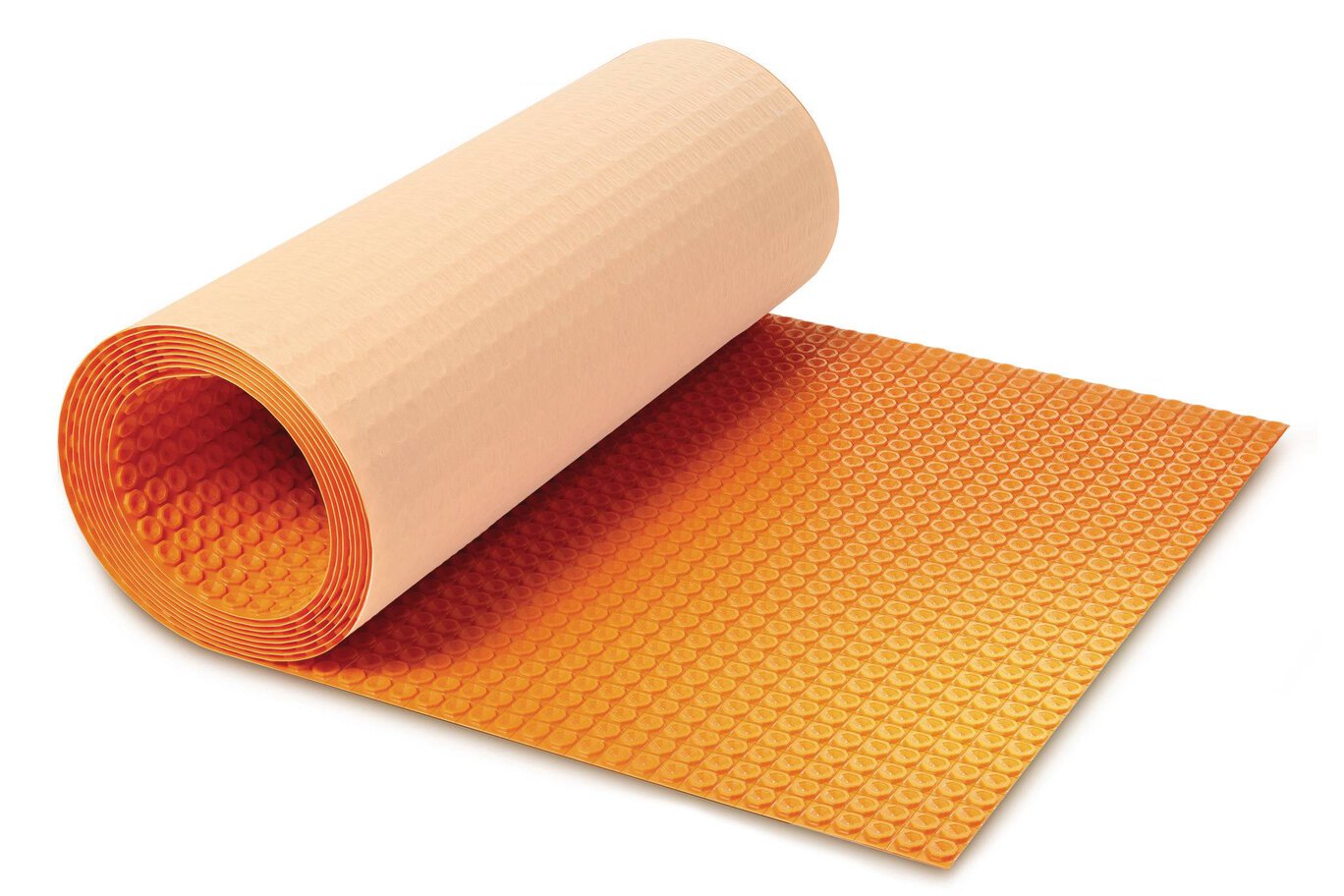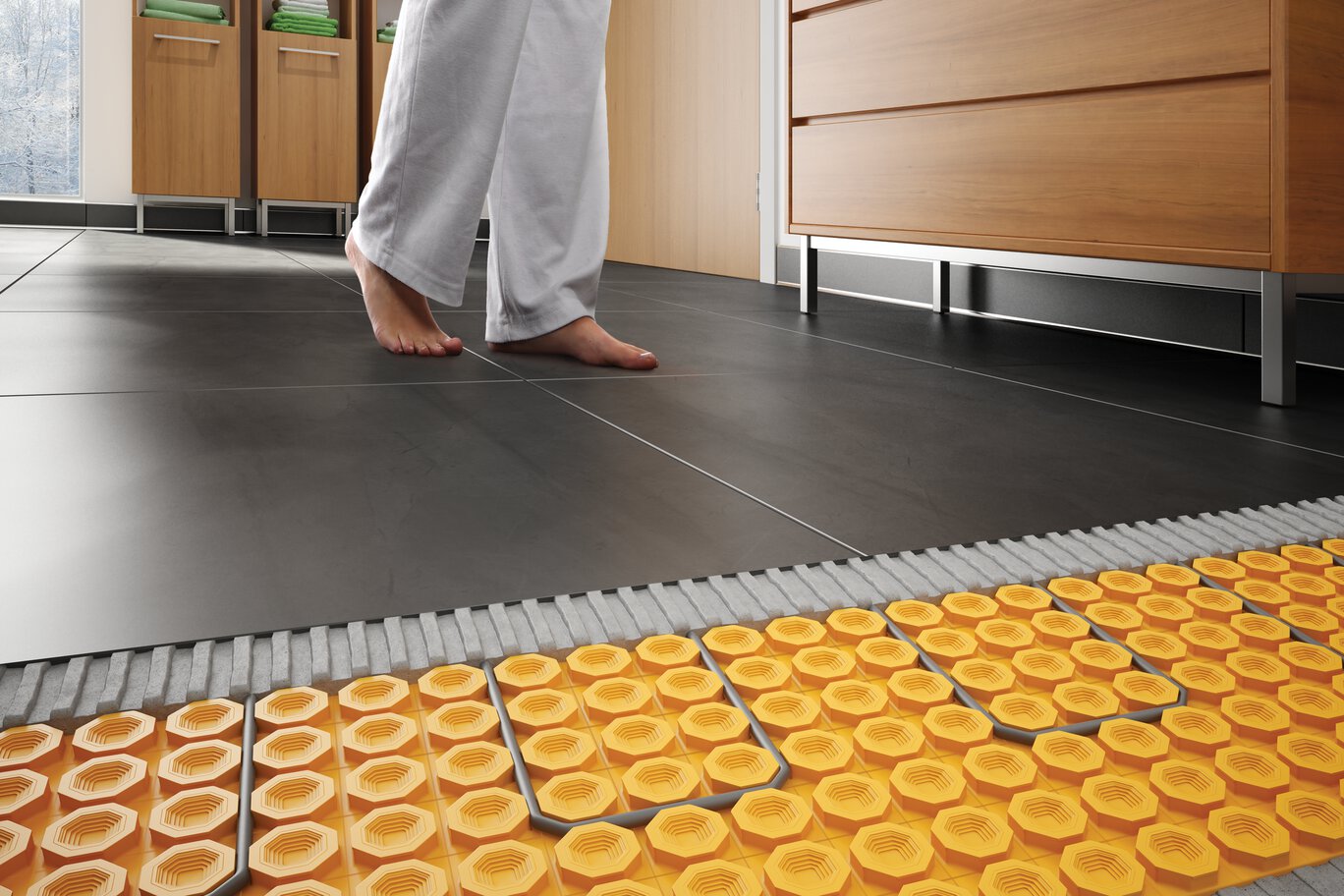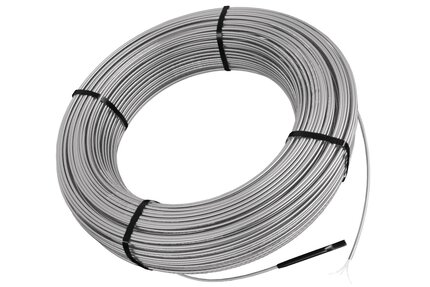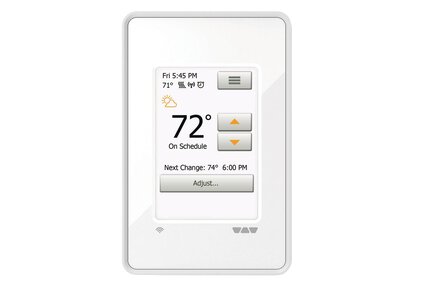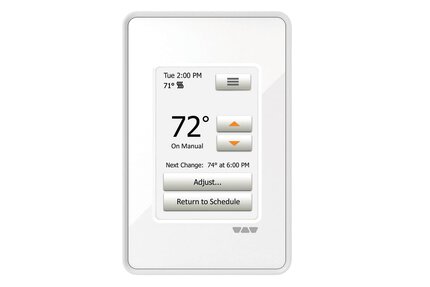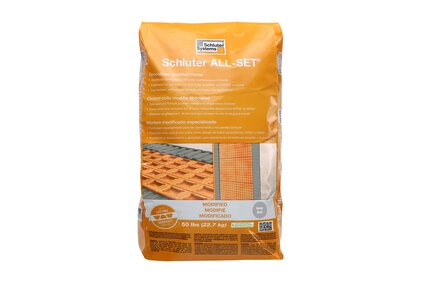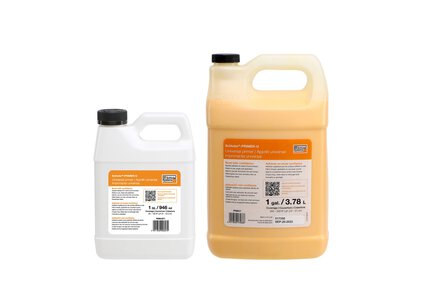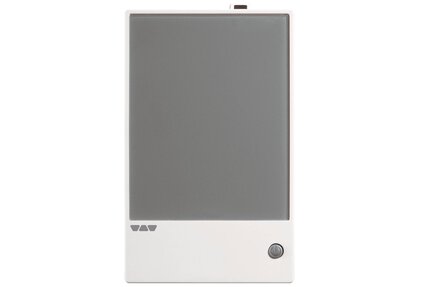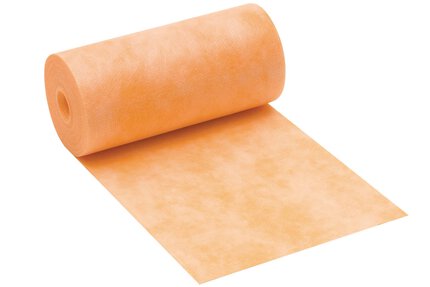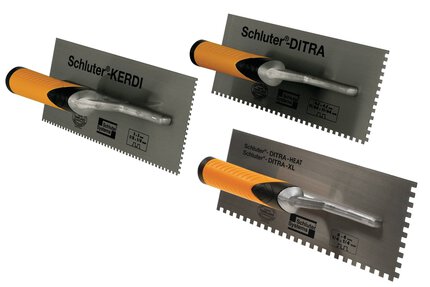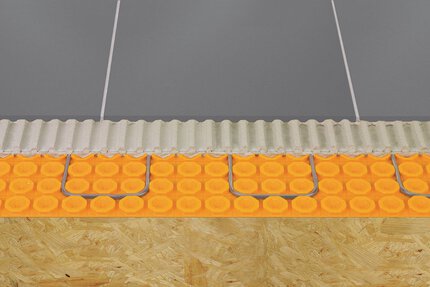Schluter®-DITRA-HEAT
Uncoupling membrane for DITRA-HEAT-E-HK electric floor heating cables
- The stud structure of DITRA-HEAT is specifically designed to allow for the easy installation of DITRA-HEAT-E-HK heating cables
- Nominal 1/4" (5.5 mm) thickness minimizes tile assembly thickness and reduces transitions to lower surface coverings
- Self-leveling compounds are not required to encapsulate the cables into the membrane
- Available by the roll or by the sheet to accommodate various room sizes
- Quick and easy to install and few tools are required
- Provides electric floor warming for use beneath tile, stone, or other resilient floor coverings (e.g. LVT)
Find recommended accessories here
DITRA-HEAT Estimator
Estimate your membrane and cable requirements without breaking a sweat.
Schluter®-DITRA-HEAT integrates customizable, comfortable electric floor warming with the functions associated with DITRA: uncoupling, waterproofing, vapor management and support to ensure a long lasting installation.
Floor Warming
DITRA-HEAT-DUO combines the flexibility of loose heating cables with the ease of installation of mat systems. Cables can be placed wherever heat is desired, without creating height differences in the floor. Self-leveling compounds are not required to encapsulate the cables for ceramic, porcelain, and stone tiles, significantly reducing installation time and effort compared to uncoupling membranes over other electric floor warming systems. Self-leveling compounds are approved for use only when installing alternative floor coverings over the DITRA-HEAT membranes.
Uncoupling
Tile has been successfully installed for thousands of years by incorporating an uncoupling layer, or forgiving shear interface, within the tile assembly. DITRA-HEAT provides uncoupling through its geometric configuration, which allows for in-plane movement that effectively neutralizes the differential movement stresses between the substrate and the tile, thus eliminating the major cause of cracking and delaminating of the tiled surface.
Waterproofing
DITRA-HEAT provides reliable waterproofing. Its polypropylene composition protects the substrate from moisture penetration, which is particularly important in today’s building environment where most substrates are moisture-sensitive.
Vapor Management
The free space on the underside of DITRA-HEAT provides a route for excess moisture and vapor to escape from the substrate that could otherwise cause damage to the tile covering above. Thus, DITRA-HEAT effectively manages moisture beneath the tile covering.
Support/load distribution
When placed on a solid foundation, columns or pillars can support tremendous loads. The same physical principle applies to DITRA-HEAT installations. Column-like mortar structures are formed in and between the studs on the surface of the matting. Loads are transferred from the tile covering through these column-like mortar structures to the substrate. Since DITRA-HEAT is virtually incompressible within the tile assembly, the advantages of uncoupling are achieved without sacrificing point load distribution capabilities.
Alternate Floor Coverings over DITRA-HEAT
DITRA-HEAT is suitable for applications with engineered wood, vinyl, wood plastic composite (WPC), luxury vinyl tiles (LVT), luxury vinyl planks (LVP), stone plastic composite (SPC) tiles and planks, and laminate flooring. See the Alternate Floor Coverings over DITRA-HEAT Technical Bulletin for more information, including requirements and limitations.
DITRA-HEAT and DITRA-HEAT-DUO membranes do not require any special maintenance.
All substrates must be clean, even, and load bearing. Bond inhibiting surfaces must be removed prior to the application of DITRA-HEAT. For complete installation guidelines and warranty criteria, please refer to the downloadable Schluter®-DITRA-HEAT Installation Handbook or to the installation video online.
Note: Type, thickness, and format of the tile or stone surface covering must be suitable for the intended application. Minimum tile format is 2" x 2" (5 cm x 5 cm).
Applications with tile formats less than 2” x 2” (5 cm x 5 cm) require special considerations, please contact Schluter-Systems Technical Services Representatives at 800-472-4588 (USA) or 800-667-8746 (Canada) for more information regarding installation requirements and warranty eligibility.
1. Using a thin-set mortar that is suitable for the substrate, apply the thin-set mortar (mixed to a fairly fluid consistency, but still able to hold a notch) using a 1/4" x 1/4" (6 mm x 6 mm) square-notched trowel.
2. Apply DITRA-HEAT to the floor, fleece side down. Solidly embed the matting into the mortar using a float, screed trowel, or DITRA-ROLLER, making sure to observe the open time of the bonding mortar. If the mortar skins over prior to matting installation, remove and reapply. Note: It may be helpful to back roll the end of the matting before installation, or place boxes of tile on top of the matting after installation, to avoid curling.
*When using the DITRA-ROLLER, place a weight (e.g., bags of mortar/grout or box of tile) not to exceed 75 lbs on the DITRA-ROLLER shelf. Slowly move the roller from one end of the matting to the other, slightly overlapping successive passes.
3. Lift up a corner of the matting to check coverage. Proper installation results in full contact between the fleece webbing and the thin-set mortar. Note: Coverage may vary with mortar consistency, angle at which the trowel is held, substrate flatness, etc. If full coverage is not achieved, remove and reapply, making sure to verify proper mortar consistency and application.
4. Abut end and side sections of adjacent sheets. Note: Aligning the studs on the top of the matting during installation can help make subsequent heating cable installation easier.
5. The DITRA-HEAT-E-HK heating cables can now be installed. Installation instructions are covered under the DITRA-HEAT-E-HK product page.
Note: Tile can be installed directly over the DITRA-HEAT membrane immediately after the Schluter®-DITRA-HEAT-E-HK cables have been installed using an unmodified thin set.
Alternate Floor Coverings over DITRA-HEAT
Please refer to detail DH-AFC (see the Technical Bulletin - DITRA-HEAT with Alternate Floor Coverings available in the Downloads tab above) and the Schluter®-DITRA-HEAT Installation Handbook for complete installation guidelines. Estimate your membrane and cable requirements to complete your specific installation.
Warranties
Brochures and Pamphlets
Handbooks
FAQ
What is the minimum stud spacing when installing the Schluter®-DITRA-HEAT-E-HK heating cables?
A cable spacing of 3 studs between runs is standard. However, cable may also be spaced at continuously alternating 3 stud – 2 stud intervals in isolated...
Read moreCan Schluter®-DITRA-HEAT-E-HK heating cables be installed on a shower bench?
Yes, DITRA-HEAT-E-HK heating cables can be installed on the top surface of shower benches. Care must be taken to install...
Read moreCan mosaic tile be used with Schluter®-DITRA-HEAT?
The minimum required tile format for use with DITRA-HEAT is 2" x 2" (50 mm x 50 mm). Please call Schluter®-Systems...
Read moreCan Schluter®-DITRA-HEAT be installed over vinyl flooring?
Yes, DITRA-HEAT can be installed over vinyl. Some limitations include the following: 1- Cushioned vinyl is unacceptable...
Read moreCan Schluter®-DITRA-HEAT be installed over hardwood flooring?
We don't recommend or warranty DITRA-HEAT installation over existing hardwood flooring as it is very unstable and difficult to bond...
Read moreCan other manufacturer’s heating cables be installed with Schluter®-DITRA-HEAT membrane?
The DITRA-HEAT-E-HK heating cables are specifically designed to integrate with the DITRA-HEAT membrane...
Read moreCan the Schluter®-DITRA-HEAT system be installed in an outdoor installation?
No, the DITRA-HEAT heating cables and membrane cannot be installed outdoors. The heating cables are not rated for exterior applications.
Read moreHow long do I have to wait after the installing Schluter®-DITRA-HEAT to start using the system?
Schluter®-Systems recommends waiting 7 days after grouting before consistent use of the DITRA-HEAT system...
Read moreCan Schluter®-DITRA-HEAT be installed over existing tile?
Installing DITRA-HEAT over existing tile may require special considerations. Please call Schluter®-Systems...
Read moreI plan to install an electric floor warming system on slab on grade. Are there any available Schluter products that can act as a thermal break?
Why is megohmmeter testing strongly recommended for Schluter®-DITRA-HEAT-E-HK heating cables?
The insulation resistance test is intended to detect very small breaks throughout the cable insulation before, during, and after installation...
Read moreWhere can I find a megohmmeter to perform the insulation resistance test?
Megohmmeters may be found at local electrical supply wholesalers or online retailers such as Grainger, Mouser Electronics, Amazon, etc...
Read moreMy megohmmeter is reading OL or I; is this a good reading for the heating cable insulation resistance test?
If your megohmmeter is reading "OL" (over load) or "I" (infinity), these are commonly used readings on megohmmeters...
Read moreHow do I connect the Schluter®-DITRA-HEAT-E-HK Heating Cables to a Schluter®-DITRA-HEAT-E-RSD thermostat?
For instructions on connecting the DITRA-HEAT-E-RSD thermostat, please reference the Schluter®-DITRA-HEAT Thermostat User’s Guides or...
Read moreHow do I program the Schluter®-DITRA-HEAT-E-RSD thermostat?
Please see the DITRA-HEAT DHE RS D/BW Thermostat user’s guide for written instructions or see the Tips, Tricks, & FAQ video...
Read moreI ran out of room for my heating cables, can I cut them or put them under my cabinets?
NEVER cut or modify the heating cable in any way. This would change the cable resistance, will cause damage to the cable, and could cause cable overheating...
Read moreHow do I select the correct length Schluter®-DITRA-HEAT-E-HK heating cable for my floor warming project?
The Schluter®-DITRA-HEAT membrane is selected according to the size of the area to be tiled. The DITRA-HEAT-E-HK heating cable is selected...
Read moreWhy are two floor temperature sensors provided with the Schluter®-DITRA-HEAT system?
Both floor temperature sensors are installed within the tile assembly. One sensor is connected to the thermostat, while...
Read moreCan Schluter®-DITRA-HEAT-E-HK heating cables be installed on walls?
What are the restrictions on where I can install the Schluter®-DITRA-HEAT heating cables?
The DITRA-HEAT heating cables cannot be installed under vanities with no air space beneath, bathtub platforms...
Read moreCan more than one DITRA-HEAT-E-HK heating cable be connected to the Schluter®-DITRA-HEAT-E Thermostats ?
Multiple DITRA-HEAT-E-HK heating cables can be connected and controlled by a single DITRA-HEAT-E thermostat, if the total current is less than 15 amps...
Read moreWhat size electrical box is recommended for a Schluter-DITRA-HEAT-E thermostat?
We recommend a single gang, deep electrical box or a double gang electrical box with a single gang mud ring to provide plenty...
Read moreHow do I choose between the 120V and a 240V Schluter®-DITRA-HEAT-E-HK heating cables?
There is no single determining factor. In general, 120V heating cables must be connected to 120V power sources...
Read moreIs it required to waterproof Schluter®-DITRA-HEAT?
Waterproofing the floor is not required, but can be beneficial in some cases. Today’s construction methods...
Read moreCan I use self-leveling compounds over Schluter®-DITRA-HEAT?
No, any leveling of the subfloor must be done prior to installing the DITRA-HEAT membrane. A major benefit of DITRA-HEAT is that self-leveling...
Read moreHow long do I have to wait before installing tile on Schluter®-DITRA-HEAT?
Once the DITRA-HEAT membrane has been installed and the heating cables have been embedded within the membrane and tested, the tile can be installed right away...
Read moreHow much thin-set mortar will be used with Schluter®-DITRA-HEAT?
The estimated thin-set mortar coverage is shown below. Coverage may vary with mortar consistency, angle at which the trowel is held...
Read moreWhat is the proper thin-set mortar consistency for installing Schluter-DITRA-HEAT?
Using a thin-set mortar that is suitable for the substrate, apply the thin-set mortar (mixed to a fairly fluid consistency, but still able to hold a notch)...
Read moreWhat type of thin-set mortar should I use when setting tile over Schluter®-DITRA-HEAT?
Schluter-Systems requires the use of Schluter SET™ , ALL-SET™ , FAST-SET™, or an unmodified thin-set mortar meeting the requirements of ANSI A118.1 to install...
Read moreHow do I receive a lifetime warranty?
Can I install alternate floor coverings over Schluter®-DITRA-HEAT or Schluter®-DITRA-HEAT-DUO instead of tile or stone?
The Schluter®-DITRA-HEAT system is suitable for applications with engineered wood, vinyl, wood plastic composite (WPC), luxury vinyl tiles (LVT), luxury vinyl planks (LVP) and more.
Read moreCan I install a tile format smaller than 2”x2” over an uncoupling membrane?
Applications with tile formats less than 2” x 2” (50 mm x 50 mm) require special considerations, please...
Read moreSchluter®-DITRA-HEAT Evaluations and Listings
Schluter®-DITRA-HEAT-DUO is listed by cUPC
Evaluations and Listings - Heating Cables
Schluter®-DITRA-HEAT-E-HK Heating Cables are certified by CSA to CAN/CSA-C22.2 No. 130-16 (Canada)
Schluter®-DITRA-HEAT-E-HK Heating Cables are certified by CSA to UL 1673 (US)
Schluter®-DITRA-HEAT-E-HK Heating Cables are listed by UL to UL 1683 (US) and CAN/CSA-C22.2 No. 130-16 (Canada)

Watch & Learn
About the product

How to install DITRA-HEAT over Wood Start to Finish

Schluter®-DITRA-HEAT: Main Functions

How to install DITRA-HEAT electric floor warming in a shower

Schluter®-Systems Warranties

Mike Holmes on Schluter®-DITRA-HEAT
Find some existing tutorials and project documentation videos to learn how-to get the best out of our products - for more fun in your life, start now!
Watch more videos / playlists
